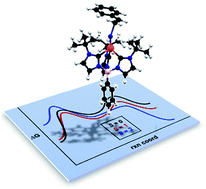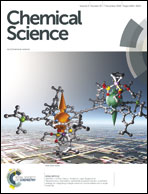Mechanistic study of styrene aziridination by iron(iv) nitrides†
Abstract
A combined experimental and computational investigation was undertaken to investigate the mechanism of aziridination of styrene by the tris(carbene)borate iron(IV) nitride complex, PhB(tBuIm)3Fe![[triple bond, length as m-dash]](https://www.rsc.org/images/entities/char_e002.gif) N. While mechanistic investigations suggest that aziridination occurs via a reversible, stepwise pathway, it was not possible to confirm the mechanism using only experimental techniques. Density functional theory calculations support a stepwise radical addition mechanism, but suggest that a low-lying triplet (S = 1) state provides the lowest energy path for C–N bond formation (24.6 kcal mol−1) and not the singlet ground (S = 0) state. A second spin flip may take place in order to facilitate ring closure and the formation of the quintet (S = 2) aziridino product. A Hammett analysis shows that electron-withdrawing groups increase the rate of reaction σp (ρ = 1.2 ± 0.2). This finding is supported by the computational results, which show that the rate-determining step drops from 24.6 kcal mol−1 to 18.3 kcal mol−1 when (p-NO2C6H4)CH
N. While mechanistic investigations suggest that aziridination occurs via a reversible, stepwise pathway, it was not possible to confirm the mechanism using only experimental techniques. Density functional theory calculations support a stepwise radical addition mechanism, but suggest that a low-lying triplet (S = 1) state provides the lowest energy path for C–N bond formation (24.6 kcal mol−1) and not the singlet ground (S = 0) state. A second spin flip may take place in order to facilitate ring closure and the formation of the quintet (S = 2) aziridino product. A Hammett analysis shows that electron-withdrawing groups increase the rate of reaction σp (ρ = 1.2 ± 0.2). This finding is supported by the computational results, which show that the rate-determining step drops from 24.6 kcal mol−1 to 18.3 kcal mol−1 when (p-NO2C6H4)CH![[double bond, length as m-dash]](https://www.rsc.org/images/entities/char_e001.gif) CH2 is used and slightly increases to 25.5 kcal mol−1 using (p-NMe2C6H4)CH
CH2 is used and slightly increases to 25.5 kcal mol−1 using (p-NMe2C6H4)CH![[double bond, length as m-dash]](https://www.rsc.org/images/entities/char_e001.gif) CH2 as the substrate.
CH2 as the substrate.



 Please wait while we load your content...
Please wait while we load your content...